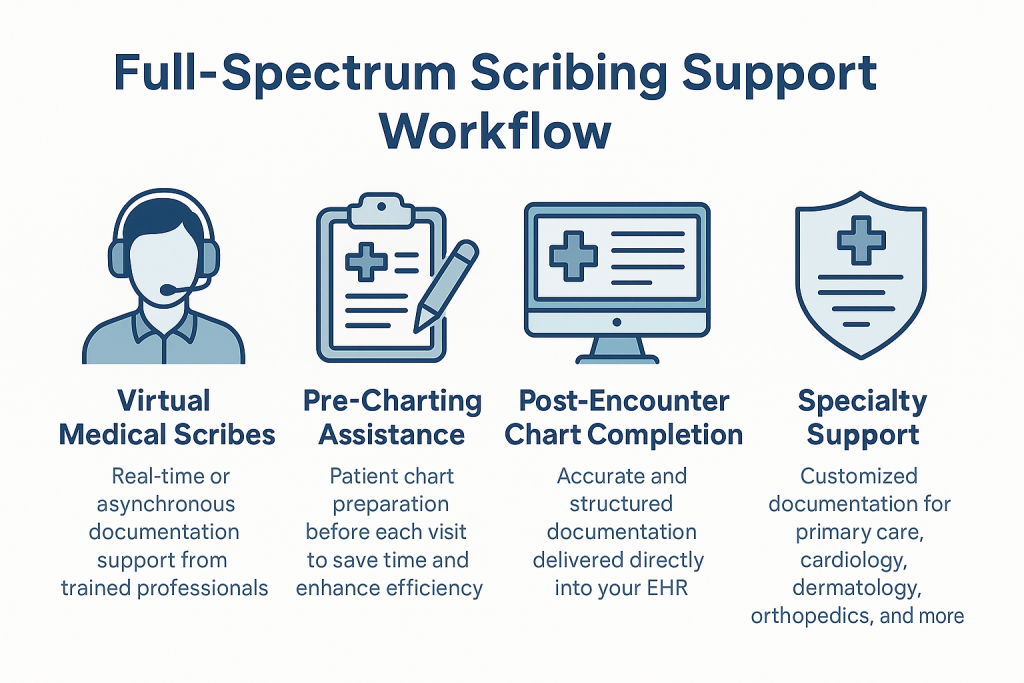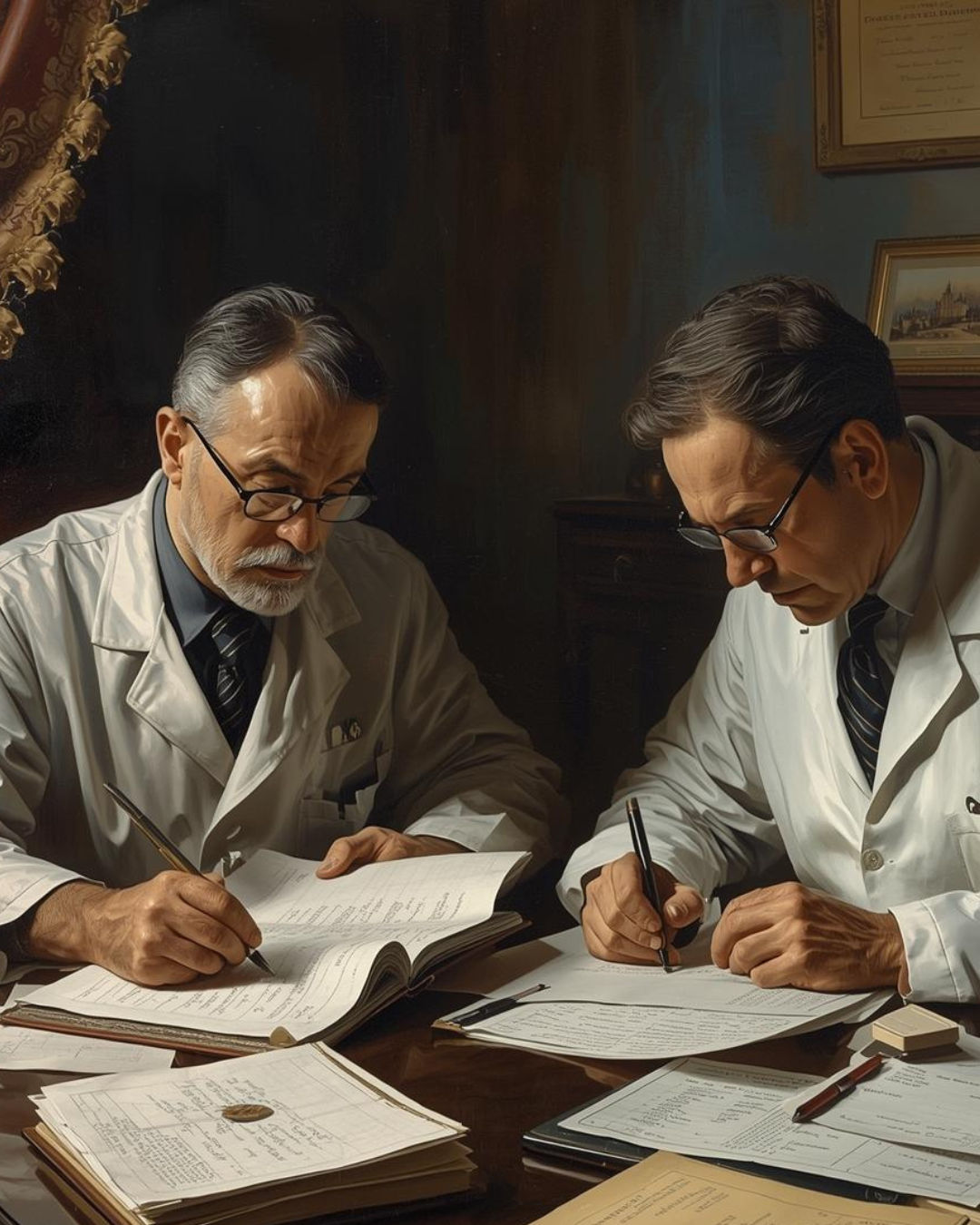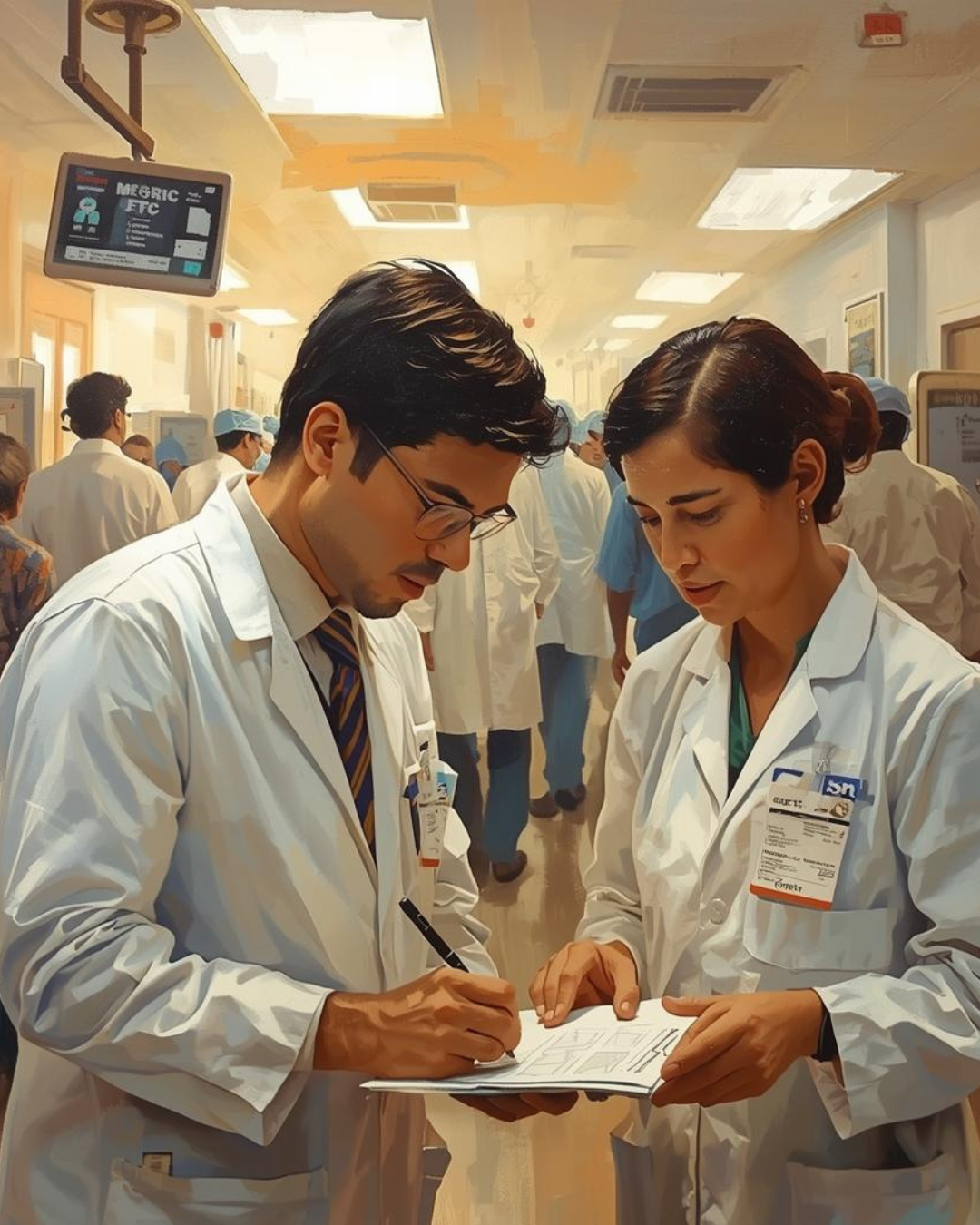Full-Spectrum Scribing: How Medical Scribes Streamline Documentation from Start to Finish

Full-Spectrum Scribing: How Medical Scribes Streamline Documentation from Start to Finish
In today’s healthcare environment, physicians face mounting pressure to balance patient care with the increasing demands of electronic health record (EHR) documentation. While technology has streamlined certain aspects of healthcare, it has also created new challenges, particularly the time-consuming process of charting. This is where medical scribes step in as a vital support system. By managing documentation tasks, medical scribes free physicians to focus more on patients, reduce burnout, and ensure accurate records.
The evolution of scribing has brought new opportunities, with both in-person and virtual scribes transforming clinical workflows. Unlike traditional approaches, virtual scribes provide real-time or asynchronous support remotely, offering practices flexibility and cost-effectiveness. Whether assisting live during patient encounters or completing notes after the visit, virtual scribes deliver efficiency without compromising quality.
Medical scribing goes beyond simple note-taking. It involves pre-charting before visits, live documentation during encounters, and post-encounter chart completion. By covering the entire documentation cycle, medical scribing ensures accuracy, consistency, and compliance across specialties. From primary care to complex fields like oncology or cardiology, a trained medical scribe adapts to the unique needs of each provider, making documentation seamless and reliable.
The concept of full-spectrum scribing highlights the importance of supporting physicians at every stage of patient care. From preparing charts ahead of time, to recording interactions in real-time, to finalizing EHR entries after the appointment, medical scribes optimize efficiency and reduce administrative burden. This end-to-end approach to documentation not only improves provider satisfaction but also enhances the overall patient experience by giving physicians more time for meaningful engagement.
As healthcare continues to evolve, medical scribes and virtual scribes have become indispensable allies in delivering accurate, timely, and structured documentation. In this blog, we’ll explore how full-spectrum medical scribing works, the stages involved, and the transformative impact it has on modern medical practice.
The Need for Comprehensive Scribing Support
The demand for comprehensive scribing support has grown significantly as healthcare providers continue to face mounting administrative responsibilities. Physicians spend a large portion of their day entering data into electronic health records (EHRs), leaving less time for patient interaction. This constant pressure not only contributes to burnout but also reduces overall efficiency in clinical settings. To overcome these challenges, healthcare practices are increasingly turning to medical scribes and virtual scribes who can provide end-to-end documentation support.
A medical scribe is more than just a note-taker. Comprehensive medical scribing involves three critical stages: pre-charting before the visit, real-time documentation during the encounter, and post-encounter chart completion. Without this full-spectrum approach, physicians often face gaps in documentation that lead to inefficiencies, billing issues, or compliance risks. By engaging medical scribes who are trained to handle all aspects of charting, providers can streamline workflows and maintain accurate, timely, and structured records.
The rise of virtual scribes has expanded access to this support even further. With secure remote connections, virtual scribes can assist providers in real time or asynchronously, depending on the practice’s needs. This flexibility is especially valuable for busy clinics and specialists who require documentation tailored to their unique workflows. Whether it’s preparing patient charts ahead of time, capturing every detail during the visit, or ensuring post-visit notes are completed accurately, virtual scribes offer a comprehensive solution that aligns with modern healthcare demands.
Investing in comprehensive medical scribing is not just about saving time—it’s about improving care quality. When physicians are relieved of excessive documentation duties, they can dedicate more attention to patients, reduce stress, and increase job satisfaction. At the same time, accurate charting ensures better communication across care teams, enhances compliance, and supports proper billing.
In short, the need for comprehensive scribing support stems from the growing complexity of healthcare documentation. By leveraging the expertise of medical scribes and the flexibility of virtual scribes, practices can achieve smoother workflows, improved patient outcomes, and a more sustainable care environment.
Virtual Medical Scribes: Real-Time Documentation Assistance
Today providers are under constant pressure to balance patient interaction with accurate record-keeping. This is where virtual medical scribes step in, offering real-time documentation assistance that transforms the way practices manage their workload. Unlike traditional in-person support, virtual scribes connect remotely through secure platforms, listening in during patient encounters and documenting information directly into the electronic health record (EHR). This seamless integration allows physicians to remain fully engaged with their patients while ensuring that every detail is captured accurately.
A medical scribe working virtually is trained to manage more than just basic note-taking. Through comprehensive medical scribing, these professionals provide structured, high-quality documentation that supports compliance, enhances billing accuracy, and reduces the risk of errors. By handling the intricacies of charting, virtual scribes free up physicians to focus on diagnosis, treatment, and building stronger patient relationships. The result is not only improved workflow efficiency but also higher.
Pre-Charting Assistance: Preparing for Patient Visits
Efficient patient care begins before the provider ever walks into the exam room. One of the most valuable services offered by medical scribes is pre-charting assistance, which ensures that physicians are fully prepared for each encounter. By reviewing prior medical history, lab results, imaging, and ongoing treatment plans, a medical scribe helps organize relevant information in advance. This process streamlines visits, allowing physicians to spend less time navigating electronic health records and more time engaging directly with their patients.
Virtual scribes extend this support even further by remotely accessing patient charts before scheduled visits. They compile critical details, flag outstanding issues, and update templates so that the provider has a clear, concise summary of the patient’s status at the start of the appointment. This proactive approach to medical scribing reduces redundancy, minimizes the risk of overlooking important information, and contributes to a smoother, more productive workflow.
For physicians, the benefits of pre-charting assistance are immense. Instead of beginning an appointment by searching through disorganized records, the doctor can immediately focus on clinical decision-making and patient communication. By leveraging the expertise of medical scribes, healthcare practices improve efficiency, reduce documentation backlogs, and ensure accuracy in patient charts. Furthermore, patients feel more valued when their physician is prepared and attentive from the very beginning of the visit.
In specialty practices—such as cardiology, oncology, or gastroenterology—where patient histories are often complex, virtual scribes play a critical role in consolidating extensive medical information into accessible notes. This not only saves time but also enhances the quality of care by ensuring that no detail is overlooked. As medical scribing continues to evolve, pre-charting support has become a cornerstone of provider efficiency and patient satisfaction.
By preparing charts ahead of time, medical scribes help healthcare providers enter each encounter with clarity and confidence. The result is faster documentation, better-informed clinical decisions, and improved patient experiences—all made possible through the skillful integration of virtual scribes into the healthcare workflow.

Post-Encounter Chart Completion: Accurate Documentation in the EHR
The patient visit does not end when the appointment is over—it continues in the form of documentation. One of the most time-consuming tasks for physicians is completing charts accurately and promptly in the electronic health record (EHR). This is where medical scribes play a crucial role. By handling post-encounter chart completion, a medical scribe ensures that all notes, diagnoses, treatment plans, and follow-up instructions are entered correctly and aligned with compliance standards.
For many providers, the burden of unfinished charts often extends late into the evening, contributing to physician burnout. With the support of virtual scribes, this challenge is significantly reduced. Working remotely, virtual scribes review encounter details, organize medical histories, and finalize documentation so that charts are accurate, complete, and ready for provider sign-off. This seamless process allows physicians to end their day on time while maintaining confidence in the quality of their records.
Accurate medical scribing is more than just a convenience—it directly impacts patient safety and practice efficiency. Incomplete or delayed charting can lead to errors in treatment plans, miscommunication among care teams, and delays in billing. By leveraging medical scribes for post-encounter support, practices ensure that documentation is thorough, standardized, and timely. This not only improves continuity of care but also strengthens compliance with healthcare regulations.
Specialty practices, in particular, benefit from this service. In fields like neurology, cardiology, or oncology, where detailed documentation is essential, virtual scribes help ensure that complex encounters are recorded with precision. From summarizing diagnostic tests to documenting medication changes, the role of a medical scribe is indispensable in capturing the full picture of patient care.
Ultimately, medical scribing for post-encounter chart completion reduces administrative strain on physicians while improving accuracy across the healthcare system. By entrusting this task to skilled medical scribes, providers can close charts quickly, avoid backlogs, and refocus their time on what matters most—delivering exceptional patient care.
Specialty Support: Tailored Documentation for Different Practices
Every medical specialty has its own unique documentation needs. A cardiologist’s notes differ significantly from those of a neurologist, and an oncologist’s documentation requirements are not the same as those in emergency medicine. This is why medical scribes are not just general assistants—they provide specialty-focused support that adapts to the demands of each practice. A skilled medical scribe understands the nuances of terminology, workflows, and documentation styles across specialties, ensuring that physicians receive tailored charting assistance.
For example, in gastroenterology, medical scribes may focus on documenting endoscopy findings and treatment follow-up, while in dermatology, they ensure accurate recording of lesion characteristics and biopsy results. In oncology, where detailed treatment histories and staging information are essential, virtual scribes provide comprehensive charting that captures the complexity of patient encounters. By aligning documentation with specialty needs, medical scribing improves accuracy, reduces errors, and supports better patient outcomes.
One of the greatest advantages of using virtual scribes is scalability across multiple specialties. Whether a clinic serves primary care, orthopedics, cardiology, or psychiatry, virtual scribes can be trained to handle the specific documentation style required. This flexibility allows practices of all sizes to maintain consistency in their EHR records while ensuring compliance with specialty-specific standards.
Moreover, specialty-tailored medical scribing enhances efficiency. Physicians no longer need to waste time explaining terminology or double-checking charts for accuracy. Instead, they can rely on their medical scribes to accurately capture the details of tests, procedures, and care plans. This not only streamlines the documentation process but also improves provider satisfaction by removing repetitive administrative burdens.
By offering specialty support, medical scribes ensure that practices receive documentation solutions that align perfectly with their clinical workflows. From real-time encounter recording to post-visit chart completion, specialty-driven medical scribing empowers physicians across disciplines to focus more on patients and less on paperwork.
Conclusion
The role of medical scribes has evolved far beyond basic note-taking. Today, they serve as essential partners in the healthcare ecosystem, ensuring that documentation is complete, accurate, and streamlined from the moment a patient is scheduled to the final closure of their chart. By supporting every phase of documentation—pre-charting, real-time encounter assistance, and post-visit chart completion—medical scribes deliver true full-spectrum support that enhances both efficiency and quality of care.
The rise of virtual scribes has made this support even more accessible and scalable. Whether in small private practices or large specialty groups, virtual scribes offer real-time charting assistance, adapting to the unique workflows of each provider and specialty. This flexibility allows physicians to reclaim valuable time, reduce burnout, and focus on patient interactions without the distraction of EHR complexities. Through consistent, accurate, and tailored medical scribing, providers can achieve better work-life balance while also improving patient outcomes.
A skilled medical scribe does more than just type notes—they bridge the gap between clinical expertise and administrative demands. By mastering medical terminology, specialty-specific documentation, and compliance standards, medical scribes ensure that every chart reflects the highest level of accuracy. This not only reduces errors but also strengthens the integrity of medical records, supporting billing accuracy, continuity of care, and overall operational efficiency.
Ultimately, the future of healthcare documentation lies in comprehensive medical scribing support. Practices that leverage both onsite and virtual scribes benefit from a seamless flow of information, reduced administrative burdens, and improved physician satisfaction. By streamlining documentation from start to finish, medical scribes enable healthcare providers to do what they do best—deliver compassionate, patient-centered care.
Full-spectrum medical scribing is not just a convenience; it is a necessity in today’s fast-paced, technology-driven healthcare environment. As the demand for efficient, accurate, and specialty-focused documentation continues to grow, medical scribes will remain indispensable in helping providers navigate the complexities of modern medicine while keeping patients at the heart of every encounter.
Latest blog & articles
Learn about new product features, the latest in technology, solutions, and updates.
Top Challenges in Medical Record Review—and How Expert Reviewers Solve Them
Medical record review January 6, 2026 Top Challenges in Medical Record Review—and How...
Medical Record Review Services: Process, Turnaround Time, and Use Cases Explained
Medical record review December 28, 2025 Medical Record Review Services: Process, Turnaround Time,...
Medical Scribe Services: Cost, ROI, and Productivity Gains for Physicians in 2026
Medical Scribe December 17, 2025 Medical Scribe Services: Cost, ROI, and Productivity Gains...



